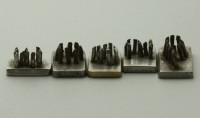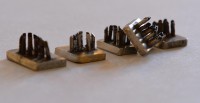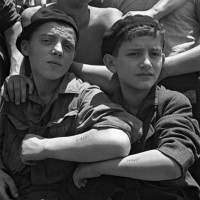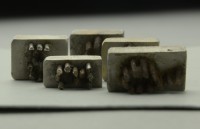 An anonymous donor has given the Auschwitz Museum five stamps used to tattoo prisoners at the death camp. Each metal block is embedded with a group of small, sharp needles arranged in the shape of a number, in this case one zero, two threes and two that could be either sixes or nines depending on which end is up. Only one other Nazi tattooing tool is known to exist — it’s in the Military Medical Museum in Saint Petersburg — which makes these grim survivals as rare as they are compelling.
An anonymous donor has given the Auschwitz Museum five stamps used to tattoo prisoners at the death camp. Each metal block is embedded with a group of small, sharp needles arranged in the shape of a number, in this case one zero, two threes and two that could be either sixes or nines depending on which end is up. Only one other Nazi tattooing tool is known to exist — it’s in the Military Medical Museum in Saint Petersburg — which makes these grim survivals as rare as they are compelling.
“It is one of the most important findings of the recent years. We couldn’t believe that original tools for tattooing prisoners could be discovered after such a long time,” emphasised Dr. Piotr M.A. Cywiński, Director of the Auschwitz Museum. “Even a tattooed number is rare to be seen now as the last prisoners pass away. Those stamps will greatly enrich the new main exhibition that is currently being prepared,” he added.
 To preserve the anonymity of the donor, the museum has released limited information about the artifacts. All they’re saying right now is that the stamps were found on or near one of the evacuation routes the Nazis used to move prisoners west when the Soviets were baring down on them from the east in January of 1945. About 56,000 prisoners were marched out of Auschwitz in columns through Upper and Lower Silesia. Most met up with trains and were transported the rest of the way. The routes covered an area 30 to 35 miles north and south of the Auschwitz-Birkenau complex, and one march was 155 miles long; a lot of ground in which to find five small metal plates.
To preserve the anonymity of the donor, the museum has released limited information about the artifacts. All they’re saying right now is that the stamps were found on or near one of the evacuation routes the Nazis used to move prisoners west when the Soviets were baring down on them from the east in January of 1945. About 56,000 prisoners were marched out of Auschwitz in columns through Upper and Lower Silesia. Most met up with trains and were transported the rest of the way. The routes covered an area 30 to 35 miles north and south of the Auschwitz-Birkenau complex, and one march was 155 miles long; a lot of ground in which to find five small metal plates.
Tattooing of prisoners began at Auschwitz in 1941 with Soviet prisoners of war. Serial numbers were first patches sewn into uniforms or attached with badges or armbands, but as more prisoners arrived and more of them died, clothing-based identification was found wanting. If their uniforms were tattered or lost, then their serial numbers were gone too. Prisoners also sometimes traded their worn clothes for pieces in better condition that had belonged to deceased inmates. Tattoos were durable and could not be exchanged.
 The first tattoos were applied using a metal stamp with interchangeable numbered plates. The needled stamps were punched against the prisoner’s skin and then ink rubbed into the wound. The early Soviet prisoners were tattooed on the chest. Later the location of the tattoo moved to the left upper forearm, first the outside and then the inside. The metal plate stamps were eventually replaced with fixed needles on a wooden shaft that were dipped in ink and then pushed into the skin.
The first tattoos were applied using a metal stamp with interchangeable numbered plates. The needled stamps were punched against the prisoner’s skin and then ink rubbed into the wound. The early Soviet prisoners were tattooed on the chest. Later the location of the tattoo moved to the left upper forearm, first the outside and then the inside. The metal plate stamps were eventually replaced with fixed needles on a wooden shaft that were dipped in ink and then pushed into the skin.
The tattoo was applied to prisoners at registration when they were assigned their serial numbers. In spring of 1942, Auschwitz authorities expanded the pool of tattooed prisoners from Soviets to other prisoners (Jews, Roma, reeducation candidates, political prisoners), retroactively tattooing people who were already registered. Eventually everyone who survived the initial sorting process was tattooed. People who were sent directly to the gas chambers were not.
 Although other camps appear to have used serial number tattoos at times, Auschwitz was the only camp to have systematically tattooed its prisoners. The recently unveiled stamps, therefore, are of great significance to the history of Auschwitz. Up until now, the museum has only had a replica of the Military Medical Museum’s tattooing device on display. The plates will be kept in the museum’s archives while the main exhibition area is revamped, after which they will go on display in the redesigned space.
Although other camps appear to have used serial number tattoos at times, Auschwitz was the only camp to have systematically tattooed its prisoners. The recently unveiled stamps, therefore, are of great significance to the history of Auschwitz. Up until now, the museum has only had a replica of the Military Medical Museum’s tattooing device on display. The plates will be kept in the museum’s archives while the main exhibition area is revamped, after which they will go on display in the redesigned space.
Thank you. “Eventually everyone who survived the initial sorting process was tattooed. People who were sent directly to the gas chambers were not.” That is such a simple fact but one that I had never thought of.
In 1960 all the parents of my class mates (in a Jewish school) had clearly legible tattoos still on their arms. I could not understand how the ink didn’t wear off in the years since 1945, nor did I understand why the survivors had tattoos. You would think the Nazis, so organised in their record keeping, would only want to keep track of the corpses.
It is now 2014 and finally the technology becomes clear. Grim but clear.
Beautifully put, Hels.
Auschwitz wasn’t actually a death camp, it was mostly a concentration camp. Mass executions were indeed carried out there, most often at the Auschwitz II Birkenau subcamp, which was designed for that, but the death camps per se, in effect factories of death, were places like Belzec, Sobibor and Treblinka. For more info see literature on Operation Reinhard.
It’s an important distinction, because a lot of people survived concentration and work camps, but very few people survived death camps, as you’d expect.
It is an important distinction and thank you very much for making it. I get sloppy sometimes when looking for word variety. :thanks:
I had always thought that the tattoos were applied by hand. Somehow the use of stamps make it seem so much worse.
I also assumed they were tattooed with individual needles, but in hindsight that would be far too time-consuming and impractical for the Nazis and their sickening, inhuman efficiency.
I’ve been to the museum where these tattoo stamps will be housed. As a college student studying abroad during the late 90’s I tagged along with two fellow classmates on a two week spring break tour of Eastern Europe. One of the stops along the way was Auschwitz-Birkenau. It was a cold day in March with minimal snow on the ground. There were only a handful of people at the museum. The entrance to the camp has the famous sign that was stolen a few years back. The first building you walk into has some information boards in various languages. The signs point you into the first room. You walk into the room, it’s long, and dimly lit. The pathway is only about 8 or 10 feet wide but on either side of you are glass walls. Behind the glass walls are rooms again, if I remember correctly, about 8 to 10 feet wide and probably 8-10 feet long. Behind the glass on either side of you is a pile of human hair about 4 feet high. It has the hair of 140,000 victims. You walk into the next room. It’s about the same dimensions and has the same walkway with glass on either side layout. The second room is filled with glasses. The third room is luggage. The fourth room is shoes. and so on and so on.
http://www.scrapbookpages.com/AuschwitzScrapbook/Tour/Auschwitz1/Auschwitz11.html
Thank you for your first-hand account of visiting the museum. The photographs of the hair and prosthetics and glasses are nothing short of chilling.
Also, great blog, keep up the good work. Your posts are part of my daily read.
Thank you for reading! I’ll do my best. :thanks:
These were the Hollerith numbers … each with an IBM punch card; a tracking system on machines. We have perfected it today. I have seen these sad tattoos on some of my friend’s parents, and one time in a shoe makers shop in germantown, pa. My travelling hippie buddy, back in the 70’s, and I, went to Dachau one summer. My humanity was wounded.
Sadness and savagery are part of the earth there. Edwin Black has all this research in his book, “IBM and the Holocaust…”
https://www.google.com/search?q=hollerith+card&safe=off&espv=210&es_sm=122&tbm=isch&tbo=u&source=univ&sa=X&ei=-JYvU6_SA9O50AGm5IDYAw&ved=0CDQQ7Ak&biw=1067&bih=721
You are absolutely right livius drusus, tattooing with individual needles who have taken way too long for the amount of prisoners they were receiving everyday at Auschwitz. According to the world record holders for tattooing, you could probably do ~100 tattoos per 24hours of non stop work. These tattoos had to be 5 numbers and had to match certain criteria (according to Edwin Black) so I think my estimate is fair. Imagine getting a trainload of ~2000 jews delivered, you can’t make those people wait on the tracks as you do 100 people in the first 24hours.. You’d have to have a huge team of tattoo artists and that’s clearly not what happened.
Unfortunately, these items that are shown as “metal tattoo plates” are fakes. Those things are used to imprint numbers onto newly made barrels. If you tried to jam those things inside someone, you’d definitely cause a wound and it would get infected.
look at this deliberately deceptive picture from the dailymail
http://i.dailymail.co.uk/i/pix/2014/03/11/article-2578422-1C32D70800000578-817_1024x615_large.jpg
His tattoo was clearly done by needle. I’m guessing it was a prison tattoo done by another inmate to inspire them to live on in the forced labor camp (you know, the reason most people get prison tattoos).
😉 HI I AM BRITANY AND I AN SO SORRY FOR YOUR LOSE.
Actually Auschwitz was the largest death camp in the Nazi collection of camps. More people died in Auschwitz than in any of the Operation Reinhard camps- which were destroyed in 1943 with the “completion” of the task of killing all of the Jews of the General Government (a bureaucratic and political state carved out of Poland and given to Otto Frank to control). The distinction is that the Operation Reinhard camps were built SOLELY for the purpose of killing in mass numbers, while Auschwitz contained BOTH a concentration camp AND a camp that was solely dedicated to killing (Birkenau). That is the reason there are more survivors of Auschwitz than the Operation Reinhard camps- because it was also used as a concentration/labor camp.
Thanks for this ionformation about how the tatoos were stamped – I had always wondered how it was done.
Suggestion: some brighter and close-up photos would be even more helpful.
GRS